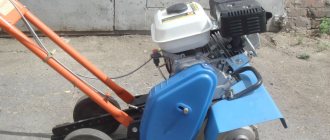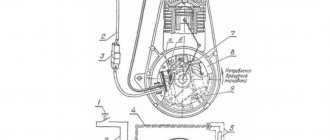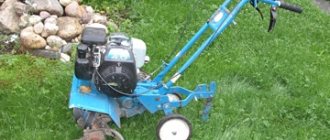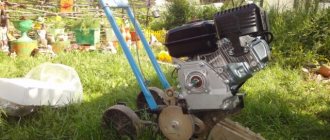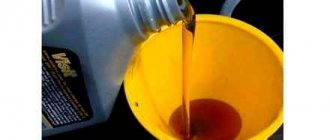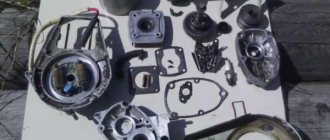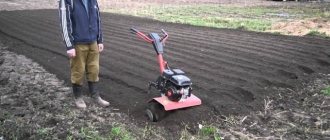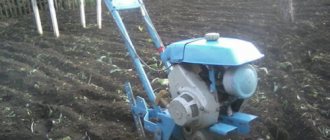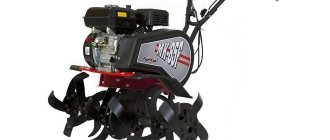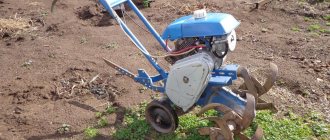The Mole motor cultivator is the first domestically produced small-sized device for cultivating land. The first model was assembled in 1983 at Moscow. It was a low-power milling-type cultivator with a limited set of functions without the ability to install attachments. The engine power reached 2.6 liters. With. with a volume of 60 cm3. The designers used the same carburetor as on the Riga mopeds, and the MB-1 electronic ignition was borrowed from the Druzhba chainsaw.
When designing the next series of motor cultivators Krot 2, the designers took into account the shortcomings of the first model. The new modification received a 4-stroke engine, a reinforced chain gearbox and reverse gear.
Modern samples meet all the requirements for compact land cultivation devices. Cultivators are assembled at machine-building plants in Moscow and Omsk.
Modifications of Mole cultivators
Let's look at the features of the most popular modifications that have appeared since the first Mole cultivator was released.
Technical characteristics of the MK series
The group is represented by middle-class models with a capacity from 2.6 to 5.5 liters. With. and weighing from 48 to 53 kg. The width of plowing land does not exceed 600 mm. The maximum tillage depth is 250 mm.
Motor cultivators of this series are designed to perform work on small summer cottages with an area of no more than 20 acres. It is possible to install attachments to expand functionality.
DDE V700II Series Specifications
A characteristic feature of the series cultivators is a powerful 6.5 liter gasoline internal combustion engine. With. AI 92 gasoline is used as fuel. The DDE 2 model is equipped with a reverse gear, which increases maneuverability and simplifies control of the cultivator.
Reliable chain gearboxes and easy starting in any weather, thanks to a manual starter, make the representatives of the series ideal assistants on large summer cottages and farms.
Technical characteristics of the cultivator Mole M
A mid-class model equipped with a reliable forced air-cooled engine from Honda with a power of 5 hp. With. The motor resource declared by the manufacturer is 1500 hours. The working width is 350 mm, and the depth is adjustable using the built-in coulter from 150 to 250 mm. Reverse gear improves maneuverability and simplifies handling of difficult areas.
The device is easy to operate and easy to maintain. Recommended fuel type is gasoline not lower than AI 92.
Modernization of the MK-1A model
If you have an old Mole model, do not rush to throw it away. Why then overpay when buying a new cultivator for the frame, gearbox and other parts if you already have them. You can get by by simply replacing the motor.
The old engine can be replaced with a four-stroke LIFAN - 160F. The Chinese engine is not expensive, plus it has a power of 4 hp. With. According to the passport of the MK-1A motor-cultivator, when cultivating the soil with cutters to a depth of 20 cm, you need to add speed. There is no need to do this with a new engine. Even with the increase in engine power, the processing depth has changed, and now it reaches 30 cm. You should not count on a greater depth, as the belt will begin to slip.
Installing a new motor on an old frame is not difficult. All fastenings are practically suitable. The only difficulty is that the original pulley will need to be altered. It is removed from the old motor, an internal hole is drilled to match the diameter of the shaft of the new engine, and then installed using a key.
If, when removing the pulley, it accidentally cracks, do not rush to run for a new one. You can try to restore it using cold welding. How to do this is best explained in the video:
The mole is considered not a bad technique for a small area, but you shouldn’t require it to perform extremely complex tasks. For these purposes, there are heavy walk-behind tractors and mini-tractors.
Models and their characteristics
A large number of models indicates that the manufacturer is continuously improving existing modifications, following modern trends and trying to launch production of cars of different classes. Thanks to cooperation with foreign manufacturers, new engines began to be installed on Krot cultivators, which have proven themselves well on foreign-made models. Let's get acquainted with the design features of Mole motor cultivators.
MK-1A
The device is a modification of the very first model. There are several options for execution. The most widely used motor cultivators are Krot MK-1A-02.
Specifications:
- Power – 2.6 l. With.;
- Clutch type – belt;
- Plowing width – adjustable within 350-600 mm;
- Processing depth – 250 mm;
- Weight – 48 kg.
The air-cooled power unit is simple and reliable. The fuel used is a mixture of AI-80 gasoline and M-12 TP oil in a ratio of 40:1. The use of a centrifugal regulator contributes to economical consumption of the fuel mixture. Torque from the engine is transmitted using a chain gearbox.
The manufacturer recommends using the cultivator for milling, loosening, harrowing, weeding between rows and leveling the soil in summer cottages and garden plots up to 10 acres. Suitable for processing difficult soils and virgin areas. Installation of additional equipment is possible.
MK 3A-3
The next stage in the development of the basic models of the 1A series.
The main characteristics of the motor cultivator include:
- Power – 3.5 l. With.;
- Clutch type – belt;
- Plowing width – adjustable within 350-600 mm;
- Processing depth – 250 mm;
- Weight – 51 kg.
The main difference between the MK 3A-3 and earlier models is the presence of reverse gear. Thanks to reverse, the performance of the device has increased due to improved controllability.
The engine for the Mole MK 3A-3 motor-cultivator is a Chinese-made GeoTeck gasoline engine.
The manufacturer recommends operating the motor-cultivator at temperatures from +1 to +40ºС. In winter, operation of the model is difficult due to the difficulty of starting and unstable operation of the motor.
The overall dimensions allow the cultivator to be easily transported in the trunk of a medium-sized sedan car.
MK-4-03
Productive model with increased processing area.
The main characteristics of the motor cultivator include:
- Power – 4.0 l. With.;
- Clutch type – belt;
- Plowing width – adjustable within 350-900 mm;
- Processing depth – 250 mm;
- Weight – 53 kg.
Device
The design of the Mole motor-cultivator provides for the following working units:
- Gearbox.
- Lever mechanisms.
- Fuel tank.
- Frame.
- Power unit.
- Support.
- Wheel.
- Cutting elements.
To transmit torque, a gearbox mounted on the engine is used. Sharp knives facilitate rapid cutting of soil layers to a depth of 25 cm, mixing and crushing them. Due to its light weight and dimensions, operating such a unit is quite comfortable.
There are levers on the handle that allow you to switch the clutch and speed. Flagship developments are equipped with a reverse and forward lever. Free movement around the beds is ensured by durable wheels that can be easily dismantled and reinstalled.
The power plants are equipped with an air cooling system and a manual cable starter. They also support contactless start.
The characteristics of the engine for the Mole MK 5 01 motor cultivator look like this:
- Volume - 60 cm³.
- Power indicators - 4.8 kW.
- Number of rpm - 5.5-6.5 thousand.
- The capacity of the fuel tank is 1.8 liters.
The motor and transmission mechanisms are connected into one single unit. The gearbox has 1 gear with movement through an A750 belt and a 19 mm pulley. To release the clutch, you must press down on the handle.
Attachments
Stores for gardeners and summer residents offer all kinds of attachments for the Mole cultivator.
This expands its functionality and allows you to perform a wide range of soil processing and plowing work.
Advanced models have the following attachments and trailers:
- Milling cutter. It is a key cutting element for plowing the ground. It uses a steel cutter with a diameter of 33 cm and a reversible plow. The knots are secured from the back with a steel chain.
- Hiller. If it is necessary to hill up garden crops, you will need to purchase special mechanisms, first removing the sharp cutters and replacing them with wheels with lugs.
- Weeder and coulter. In order to combat rapidly growing weeds, farmers equip their cultivation units with a weeder and a coulter. They hang directly on the cutter instead of sharp knives.
- Potato planter KS-01C and potato diggers. Planting and harvesting potatoes requires a lot of effort and expense. To simplify the upcoming lesson, you can equip the Krot MK 9 01 motor-cultivator with useful attachments. Special seeders are used to sow seeds of grain or vegetable crops.
- Mower. The device allows you to make hay for livestock. It is placed on the gear shaft, connecting the straps to the pulleys.
- Pumping stations and pump. They must be used to organize an uninterrupted supply of water to the garden.
- Cart. This type of trailer design is designed for transporting heavy loads from one place to another.
- Snow dumps. Designed for clearing snow from the garden area. Rotary-type models are able to get rid of thin ice. With a simple modification, they can be turned into a full-fledged snow removal tool.
- Petrol cultivators Mole are equipped with a plow.
The presence of the listed equipment will allow you to solve important problems in a short time.
Fuel consumption by Mole cultivators
Mole cultivators with two-stroke engines operate on a fuel mixture, which consists of AI 76 or 80 gasoline and M12-TP or MG-8A oil. The exact mixing proportions are indicated in the user manual. The mixture is best prepared in a dry canister for storing petroleum products. First, gasoline is poured into the container. Otherwise, the oil will stick to the bottom of the canister, which will complicate the process of preparing a quality mixture. Average fuel consumption – 1300 g/hp*h.
Models with four-stroke engines cause fewer problems for owners. The fuel is AI-92 motor unleaded gasoline, which does not need to be mixed with oil. At the same time, the average fuel consumption of such devices is noticeably lower - 530 g/hp*h.
" Note! For work at an altitude of more than 1500 meters above sea level, the use of low-octane gasoline is allowed. At the same time, the jets on the carburetor are changed to correct the composition of the air-fuel mixture.”
Oil features
Despite the simplicity of design and use, there are several points, ignorance of which will negatively affect the operation of the unit. For example, what kind of oil to fill.
You will need three types of oil for the Mole walk-behind tractor : separately for the fuel mixture, oil for the engine gearbox and for the output gearbox.
- For the fuel mixture, M-12 should be used in a ratio of 1:20 to gasoline. This is a common type of oil used for two-stroke gasoline engines.
- The oil in the gearbox of the Mole walk-behind tractor should be MG-8A. This is the so-called hydraulic oil.
- For the output gearbox, you should purchase transmission oil TAD-17.
You can choose a manufacturer based on your financial capabilities. There are domestic brands that are cheaper, and imported ones that are correspondingly more expensive.
It is highly recommended not to use pure gasoline as fuel.
You should always check the amount of oil in the engine gearbox. Its level should always be higher than the inspection hole mark. If the levels match, simply add 0.2 liters through the special hole.
It is not worth preparing the fuel mixture directly in the tank of the unit; it is better to use a separate vessel for this purpose. If there is no other way, then first pour in half of the required volume of gasoline, then all the oil, stir for about ten minutes, and only then add the second half of gasoline.
Operation of Mole motor cultivators instructions
The user manual contains general characteristics of the model, design features, maintenance intervals, recommendations for the safe operation of the cultivator and other important information. The quality of work performed and the service life of the device depend on compliance with the instructions.
The use of attachments is intended to expand the range of work performed. Let's consider all the possibilities.
Plowing
This is done using a special plow. Before performing work, you can adjust the basic parameters - plowing depth and blade angle, choosing the optimal position depending on the type of soil.
There should be no stones or large branches on the land to be cultivated. The speed and direction of movement are chosen based on the geometric shape and characteristics of the site. For example, it is more convenient to cultivate a rectangular vegetable garden moving in a circle, and a square one – moving in zigzags. If there are a lot of small stones in the ground, it is better to perform work at low speed to avoid injury.
Hilling
Sprinkling the lower part of the plant with loose soil is done using a hiller, which is installed in place of the opener. The purpose of the procedure is to protect the stem, stimulate growth, control weeds, as well as drainage and aeration.
Weeding
Removal of weeds that interfere with the normal growth of beneficial crops. This procedure is recommended to be combined with hilling.
Planting and digging potatoes
Mechanization of planting and digging potatoes saves effort and time. To carry out the work, you must first mark the area. Then they begin cutting furrows and then planting potatoes. The furrows are filled using a hiller.
It is better to harvest in warm and dry weather. In this case, soil will not stick to the tubers.
Mowing grass and making hay
To work with grass, you will need to install a rotary mower. With its help, you can quickly tidy up the lawn, clear the area of weeds and prepare hay for animals. To work on flat areas, you can use a segment mower. Mowing grass on surfaces with complex terrain is carried out using rotary attachments.
The belt is an important detail
The V-belt for the motoblock Mole, Cayman, Patriot, Texas, Foreman, Crosser, Viking, Forza is one of the most necessary elements for the functioning of the unit. Its purpose is to transmit torque from the engine to the components. If you don’t know which belt is on the “Mole” walk-behind tractor, you have the classic A 750 version.
The size of the belt for the “Mole” walk-behind tractor in this case is easily determined - the marking corresponds to it in millimeters. Typically, Soviet and modern Russian designs use just such a detail. On the other hand, you need to check your Mole walk-behind tractor. Drive belt, its size can be 785 mm. Width – 12 mm.
The belt for the Mole walk-behind tractor is used only in this temperature range: -30°C to +60°C.
Belt
Just like the oil level, the condition of the V-belt must be constantly monitored . A crack, deformation, change in size - this important part must be changed immediately, since unstable operation of the belt will lead to breakdown or deterioration of the entire device. Replacing it is quite simple.
Selecting attachments
Before purchasing attachments for the Mole cultivator, you must acquire a special coupling device. It can be used to install additional accessories. Depending on the type of design, the coupling device can be non-adjustable or movable. In the first case, the hitch is rigidly fixed without the possibility of adjusting the location, and in the second, the installation angle can be changed, depending on the nature of the work.
Let's look at the most common types of attachments, as well as their design features. Please note that if you have certain skills, you can make auxiliary equipment for a mole cultivator with your own hands.
Plow
To install the plow, the cutters and coulter are removed from the cultivator. Grousers are put on the gearbox shaft, and a reversible plow is installed in the rear using a coupling device. It is used to plow the soil.
When choosing a plow for the Mole motor-cultivator, you need to pay attention to the build quality and strength of the materials. The structure must be collapsible. This will simplify the maintenance and repair of the device - the broken element is simply removed and replaced with a new one.
Trailer
To install the cart, the rotor attachments and coulter are removed from the cultivator. The drive wheels are installed in the front part of the device, and the trailer is installed and secured using a pivot assembly.
Using a trailer you can transport fertilizers, humus, soil, hay and even construction materials.
High-quality trolley models are equipped with seats and closed compartments for storing tools. We advise you to pay attention to the quality of the body. Products assembled from galvanized steel will last much longer than similar devices without protection, due to their high resistance to adverse external factors.
Wheels
Unfortunately, only small transport wheels are commercially available. To install full-fledged pneumatic tires on disks, you must independently upgrade the cultivator, which requires additional financial costs and time. It’s easier to buy lug devices.
Reverse speed at home
Reverse speed on the “Mole” walk-behind tractor is not present in all models . Sometimes it even depends on where the unit was produced - in Moscow or Omsk. Fortunately, craftsmen have come up with a simple way to improve the Mole walk-behind tractor. Modernizations come in different forms.
Fans of DIY improvements may be interested in a homemade grain crusher.
Here is one of the recipes for how to make reverse gear on a “Mole” walk-behind tractor. The nut that holds the pulley of the agricultural machine is unscrewed. We string a pulley next to it from, for example, a Volga. We tighten the nut.
In the design of the pressure roller we use a timing belt from any foreign car. And, in fact, the switch in the front of the walk-behind tractor is a small metal bar connected to the entire pressure roller mechanism. The bar is attached to two springs and a cable runs from it to the switch handle on the handle.
Tracked module
Installing a tracked module will allow the cultivator to navigate off-road, loose snow and other difficult surfaces. The device provides good cross-country ability on all types of surfaces, increases stability and eliminates the possibility of equipment slipping.
Track tracks are usually made of polymer materials. This approach makes it possible to reduce the weight of the structure, which will reduce the load on the drive mechanism.
Nowadays it is quite difficult to find a tracked module adapted for installation on the KROT cultivator. We recommend looking for universal mechanisms that are produced for MB type walk-behind tractors. Some models are compatible with the products of JSC MMP im. V.V. Chernyshev".
Lugs
They are made of high-quality metal with a special coating that protects the structure from corrosion and external influences. Grousers are used to improve traction with the supporting surface and increase the weight of the cultivator, which simplifies movement on loose soil.
The main parameters of lugs are diameter and width. Due to the simplicity of the design, many cultivator owners prefer to make this type of attachment themselves.
snow blower
Snow blowers are designed to clear snow from paths, sidewalks, garden plots, parking areas and other places where the use of large equipment is difficult or impractical.
The principle of operation of the mechanism is based on the rotation of the shaft, which captures the snow mass and moves it to the center with subsequent release through a special bell. The range depends on the engine speed.
Potato planter
Simplifies the process of planting root crops. The simplest models are designed for planting potatoes in one row with a given step. Productivity depends on the type of model and the capacity of the planting material hopper.
High-quality models perform a full working cycle in one pass - the device cuts a furrow, pours potatoes into the holes, covers them with soil and forms even rows. In this case, the depth of processing, planting frequency, row spacing, as well as the height and shape of the ridge can be set in advance.
Potato digger
Helps in harvesting. The simplest fan design is a ploughshare with welded curved metal rods. The use of such devices allows for the presence of weeds during the work process.
The operating principle of the potato digger is as follows:
- The ploughshare loosens the ground with its sharp edge;
- The root crop is removed from the ground and falls on the inclined part of the ploughshare, moving towards the rods;
- The soil separates from the potatoes and falls to the ground through the rods;
- Clean root crops fall onto the arable land.
Many plot owners make their own equipment for harvesting potatoes.
Weights
The purpose of this attachment is to increase the total weight of the cultivator. This makes it easier to navigate difficult surfaces due to better traction.
A classic weighting agent is a cylindrical metal container that is filled with bulk materials.
Repair instructions
Repairing the “Mole” walk-behind tractor is simple and quite possible at home. Just take some time to read the instructions and understand the circuit diagram of the device. Then you can repair the “Mole” walk-behind tractor with your own hands without much difficulty.
There are things that will help you repair the “Mole” walk-behind tractor with your own hands. Video is one of them. Craftsmen will clearly show how and in what sequence to repair equipment. Although the equipment is reliable, even it, due to its use in conditions of prolonged multifunctional work, can break down.
But it is also important to understand what caused the Mole walk-behind tractor. Repair instructions may not include a video.
- The problem is the ignition. This, unfortunately, happens quite often in this brand of walk-behind tractors. The first thing to do is check the spark plug. To do this, unscrew it and carry out a visual inspection. If the spark plug is completely dry, this indicates that the fuel-air mixture is not entering the cylinder.
- If it is completely wet, you should bleed the engine using a manual starter. This will dry out the cylinder. The spark plug is burnt - wash it with gasoline and clean it with fine sandpaper.
- Malfunctions of the “Mole” walk-behind tractor may also be due to the fact that the spark plug not only needs to be cleaned, but needs to be replaced . This is the case if there is no spark.
- If there is still no spark with the new spark plug, there is a possibility that there is no contact in the electrical circuit.
- Ignition is also directly dependent on the condition of the gasoline hoses, the insulation of high-voltage wires or their connection. Take a closer look to see if the flywheel plates are touching the magneto's magnetic circuits. This shouldn't happen.
- And, of course, check the air filter for contamination. By the way, even a dirty muffler negatively affects the performance of the unit.
Possible malfunctions and repairs
Despite the fact that the design of Krot cultivators is simple, violations of the operating instructions, failure to comply with maintenance regulations, as well as the use of low-quality fuel can lead to breakdowns of the device.
Let's look at the main causes of malfunctions, as well as ways to eliminate them.
Engine
The first models of Mole cultivators had many complaints from owners regarding the poor build quality of the engines. The main problems were low resource and frequent failures. Another common malfunction that every second owner has encountered is deformation of the exhaust valve with subsequent wear of the piston.
Manufacturers found a way out of the situation - they began installing proven imported engines on new models, which had proven themselves well abroad.
Ignition
The main ignition problems include:
| Possible faults | Remedies |
| No spark | Make sure the spark plug is working properly. Cleaning and purging of electrodes. Setting the gap. If necessary, replace with a new one. |
| Problems with suppressive resistance | Check serviceability. If necessary, replace with a new one. |
| Unreliable high-voltage wire connection | Restore normal connection. |
| Violation of the integrity of the wire insulation, short circuit of current-carrying elements or the “START” button to the housing | Restoring insulation. Finding and eliminating short circuits. |
| The magneto cores touch the flywheel plates | Insulate the magnetic circuits of the magneto. |
| Magneto has failed | Replace magneto |
| Air filter clogged | Checking and purging the filter. Replace if necessary. |
| Cracks in fuel pipes | Restoring the tightness of tubes. Replace if necessary. |
Replacing the magneto in the Mole cultivator
The magneto in Mole cultivators cannot be repaired. If it fails, you just need to install a new device. As was written above, domestic devices have good maintainability. The magneto replacement procedure confirms this.
Scheme of work execution:
- Remove the starter, holding the impeller;
- We remove the magnets using a special device;
- We take out the faulty magneto and install a new one;
- We solder the button and carry out assembly and performance testing.
Carburetor
The ease of starting the engine and the stability of its operation depend on the condition of the carburetor. The penetration of dust and small debris leads to blockages that will prevent the rated power from being achieved.
The carburetor is responsible for forming the air-fuel mixture. The unit requires periodic adjustment, in accordance with the manufacturer's instructions. This procedure is carried out at least once a season, as a rule, before starting work. Carburetor adjustment is carried out in idle mode.
At the beginning of the season, it is recommended to check the carburetor for condensation that may have accumulated during inactivity. The unit is washed with a special liquid. Carburetor cleaner can be purchased at any automotive store.
Gearbox
The gearbox transmits torque from the engine to the working parts. Checking this unit comes down to monitoring the lubricant level. Working without oil will lead to rapid wear of all gearbox parts. The frequency of inspection is daily, before performing work.
Reverse
The cultivator reverse usually does not work when the adjustment settings are reset. To restore the functionality of the mechanism, perform the following operations before starting the engine:
- Screw in the adjusting screw until it stops;
- Insert the bracket into the first two holes from the lever mounting axis;
- Start the engine and engage reverse.
If reverse does not work, turn out the adjusting screw until reverse gear is engaged. These operations must be repeated several times.
The adjusted reverse gear is activated with a characteristic click, without any extraneous sounds. There are no cases of spontaneous gear shifting.
Another probable reason for the lack of reverse is a mismatch of gear teeth and gear cavities. In this case, it is necessary to move the lever to the “STOP” position and crank the engine manually using the starter.
Belt
The V-belt is responsible for the operation of the clutch. To protect against mechanical damage there is a special casing.
Correct adjustment affects the reliability and life of the belt. The recommended deflection value is 26 mm. During operation, the tension is adjusted using a screw located on the handle.
Owner reviews
Vladimir, 42 years old
“Having bought the Mole, I immediately put it to work. At first I was very upset, because the virgin soil did not give way, “Mole” clearly could not cope with its task. But having turned to a friend for advice, I realized that you can’t take such soils in the heat of the moment; you must first break in the engine, prepare it for such loads. Then I learned that it is better to plow such land in several stages, cutting deeper and deeper each time. Things went well. Over the past 7 years (from the date of purchase) I have purchased everything necessary for planting and digging potatoes, and last year I acquired a cart. I haven’t used it as a hay mower, there’s no need for it. So now I don’t regret the purchase.”
Andrey, 28 years old
“I bought Krot in 2014. At first, I spent a long time choosing, studied all the weak and strong points and decided to settle on the MK-5-01 cultivator with a Honda engine. Works stably without a break! I can freely take 10 acres at a time. I strengthened the frame a little last year, I try to keep it clean - problems with ignition, etc. I don’t care about! Over the three years of operation, “Mole” has earned its value many times over!”
Preparing the cultivator for storage
The rules for storing a cultivator differ depending on the duration of inactivity. For short-term storage, up to 3 months, the engine is started until the fuel in the carburetor is completely exhausted. Then daily maintenance is carried out followed by lubrication of the moving elements.
For long-term storage, up to one year, in addition to the above work, pour 70 grams of oil into the cylinder and manually turn the crankshaft several revolutions. The surface of the cultivator is wiped with a rag soaked in gasoline. This will prevent the formation of corrosion spots.
Spare parts and additional equipment
Attachments for walk-behind tractors Krot, Sadko, Don, Huter, Profi, Plowman, Champion are diverse. You can turn your assistant into a wheelbarrow tractor, use it for cultivating potatoes, as a lawn mower and as a water pump for watering your garden or garden. The number of parts is small.
Plow
If there is a need and desire, you can unhook the cutters from the unit and install wheels in their place. And attach a plow for the “Mole” walk-behind tractor to the device. It is installed in place of the opener. When cultivating soil, it works best in conjunction with cutters.
Milling cutters
Knives, as they are commonly called, cutters, are installed on the gearbox shaft . The cutters for the Mole walk-behind tractor rotate, while removing the top layer of soil, mixing and crushing it. Plus, thanks to these rotational movements, the device moves forward.
The standard configuration includes four cutters, but their number can be increased to six. How deeply the soil is loosened depends on the position of the attached coulter.
Oil seals
There are five oil seals for the Mole walk-behind tractor . Their task is to maintain sealing in connections. Their place is the crankshaft journal. The unit is equipped with a two-stroke motor, which is considered especially vulnerable if the seal is broken.
If the seals have become unusable, the engine will have difficulty starting, and the speed will be unstable when idling. These parts can only be replaced - their repair is not possible.
Pulley
The pulley for the motoblock Mole, Carver, Husqvarna, Lifan 6.5, Salyut, Niva can be made of materials such as cast iron, steel, aluminum. Parts made of light alloys are considered the most attractive for installation If you are thinking of changing the engine on your “Mole”, then take care of purchasing pulleys.
You will need parts with an internal diameter of 20 mm, 19.05 mm, or 18 mm - depending on which motor you like.
The pulleys are located in the same plane with a deviation of no more than 1 mm.
Pulley
Piston ring
The piston ring of the Mole walk-behind tractor is replaced if the gap at the joint of the rings is more than 1 mm . They are inserted one by one into the cylinder to a depth of eight to ten millimeters.
There is a whole so-called cylinder-piston group for the Mole walk-behind tractor unit. There are two piston rings in it. The material from which the rings and other parts of the group are made, as well as the accuracy of their fit, greatly influences the working life.
Here are the elements of this group:
- Piston pin 11mm;
- Piston rings 2 pcs. ;
- Cylinder;
- Piston.
To prevent the parts of the cylinder-piston group, and all the others, from drying out, do not let the walk-behind tractor stand idle for more than one season. This has a detrimental effect on the device, which, if used regularly, practically does not kill.
The magneto on the “Mole” walk-behind tractor, namely its coil, becomes inoperative when the equipment is left idle for a long time.
Wheels
Wheels for the Mole walk-behind tractor can be completely different, depending on the work that is planned to be carried out. Sometimes they simply rise or are removed altogether. This is what they do when weeding. One way or another, wheels for all occasions are not provided for the walk-behind tractor.
Wheels differ from each other in the material from which they are made, width, diameter, and seat size. For example, when working among rows of crops, narrow tires are needed, while when digging up potatoes, wide tires are needed. And when the gearbox is located above the plants during operation, the diameter of the wheels must be large so as not to damage the crop.
Cultivation is the loosening of soil that has previously been processed, cutting off weeds and other plants harmful to the crop. A do-it-yourself manual cultivator will save you a lot of money.
A very pressing issue is the treatment of trees and other greenery with special chemicals, which will provide protection against parasites. Here is all about the advantages of the Marolex sprayer.
ZIL-130 is a common Soviet-era truck. By clicking on the link you can familiarize yourself with its technical characteristics.
Since the mass of the walk-behind tractor is small, rubber wheels will not always be able to pull it out and turn and slide. In this situation, metal wheels with special lugs are put on.
Air filter
An important element thanks to which the normal power of the unit is maintained and less fuel is consumed. The air filter for the Mole walk-behind tractor cleans the air masses from all kinds of particles and dust, which are sufficient when working in the field.
The material from which it is made is paper, which is based on cellulose fiber. If the filter is dirty, the air-fuel mixture will not function properly in the carburetor, which will negatively affect the operation of the device. Contamination is assessed visually.
If the filter is still dirty, it must be replaced immediately. Alternatively, it can be disassembled and cleaned, but this is only in case of surface contamination.
Disassembling the filter proceeds as follows:
- The filter housing is removed by unscrewing the nut on it.
- The body is washed with water and wiped dry.
- The filter element can be cleaned with a jet of air.
- If this does not help, the filter is replaced.
Never operate the walk-behind tractor without a filter element.
How to make a replacement
Trouble-free operation of the mini tractor will depend on compliance with the installation and connection sequence.
- Unscrew the factory fastening and remove the casing.
- Disconnect the wires and disconnect the belt.
- Carry out dismantling.
- Attach the new engine and mark the new mounting holes on the frame.
- Install the engine and put on the belt.
- Adjust the belt tension by moving the motor.
- Align the unit so that the motor pulley and gearbox are in the same plane and positioned coaxially.
- Drill through holes and secure the walk-behind tractor engine with bolts 35 mm long.
- Connect the clutch, gas and muffler system.
- Carry out a run-in at idle speed.
Specifications
- The working width is 400-600 mm;
- Rotor diameter with knives – 320 mm;
- Tillage productivity – 150-200 m2/hour;
- Cutting depth – 250 mm;
- Overall dimensions in working position: length – 1000-1300 mm, width – 350-800 mm, height – 710-1060 mm;
- The weight of the walk-behind tractor with an empty tank is 51.5 kg.
Review of Mole motor cultivator models
About the disadvantages of a walk-behind tractor
The multifunctional walk-behind tractor Mole has its drawbacks:
Motoblock Mole at work
- The main disadvantage of the device is its low-power engine. With more volume there would be more opportunities.
- The open type design leads to severe contamination during operation. Dust clogs hard-to-reach places where there shouldn’t be dirt.
- Stones, roots, clods of earth get into the gap between the body and the knives, making work difficult.
- Only one operating speed.
- The service life of a 2-stroke engine does not exceed 400 hours.
- A narrow strip of land is processed in one pass.
- The piston group fails after 1-2 years and must be replaced.
- After replacing the engine with a more powerful model, the frame has to be strengthened with additional parts.
- High price of the unit.
How does a walk-behind tractor work?
The domestic walk-behind tractor has a rational design - there is nothing superfluous in it. At the same time, the cultivator can be equipped with attachments that allow it to be used for a variety of economic purposes. The equipment is reliable and can withstand long-term loads.
Components of the design:
- A frame consisting of two half-frames and attached to the gearbox with bolts.
- Tubular handle and bracket - for placing attachments.
- Control levers. The handle is equipped with controls - you can switch the clutch and engine speed. Some Krot models are equipped with an additional reverse switch.
- Pneumatic wheels attached to the output shafts of the gearbox.
- Two-stroke single-cylinder engine. The cooling system is air. The engine is attached to the frame, it is connected to the gear shaft using a V-belt type transmission.
- The walk-behind tractor is equipped with cutters - two external and two internal. A coulter is also included. If necessary, it is equipped with a hiller, potato digger, plow, pump, and mower.
Features of the Mole design:
- A V-belt transmission connects the engine for the Mole walk-behind tractor and the gear reducer to each other. The latter has a chain drive and is secured to the frame with bolts. A fuel tank is located above the motor and gearbox.
- To change the clutch, the mini-tractor has a special handle - the same as on mopeds. The clutch is in the disengaged state; when it is turned on, the belt is tensioned and torque is transmitted without slipping.
- On the output shafts of the gearbox there are working cutters, which are used to cultivate the soil, or wheels - they are needed for transporting goods and for plowing the soil with a plow. A milling cutter is a rotor with special knives that, rotating and moving forward, cut and crumble the soil.
On a note!
Milling cutters, compared to a plow, loosen and mix fertilizers more thoroughly. They can work effectively on virgin and heavy soils.
The cultivator is equipped with built-in wheels for moving. Before starting work, they are dismantled or, lifted, fixed in the desired position. Run-in is carried out for 15 hours, giving partial load.
Characteristics of the motor cultivator:
- weight (empty tank) – 51.5 kg;
- processing width – 40-60 cm;
- rotor diameter (including knives) – 32 cm;
- insertion depth – 25 cm;
- dimensions (LxWxH) – 100-130x35-80x71-106 cm;
- productivity – up to 200 sq. m/h.
Details about the engine
The first models of walk-behind tractors were not particularly powerful. Despite this, they had great motor potential. The standard 2-stroke engine produced only 2.6 hp. These units of power were only sufficient for menial tasks. As already mentioned, this caused dissatisfaction on the part of technology users. As a result, the developers carried out a number of activities that were related to the modernization of the main productive element. The efforts made have yielded results. Thus, the current “Moles” are equipped with four-stroke performance elements taking into account foreign technologies. The engine controls are located on the steering wheel.
Let us list the main advantages that all summer residents emphasize:
- Multifunctionality;
- Compact dimensions;
- The CPG is hidden behind a cast iron sleeve;
- Engine with reserve service life;
- reliable gearbox;
- efficiency.
